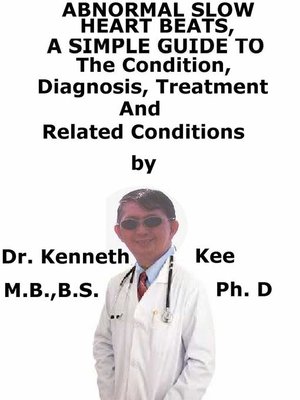Abnormal Slow Heart Beats, a Simple Guide to the Condition, Diagnosis, Treatment and Related Conditions
ebook
By Kenneth Kee

Sign up to save your library
With an OverDrive account, you can save your favorite libraries for at-a-glance information about availability. Find out more about OverDrive accounts.
Find this title in Libby, the library reading app by OverDrive.



Search for a digital library with this title
Title found at these libraries:
| Library Name | Distance |
|---|---|
| Loading... |
This book describes Abnormal Slow Heart Beats, Diagnosis and Treatment of Bradycardias and Related Diseases
Brady-arrhythmia is an abnormal slow heart rhythm and heart beat.
There are many types of Brady-arrhythmias.
They are categorized by some doctors by where they start in the heart (the atria, AV node, or the ventricles).
An arrhythmia is a disorder with the rate or rhythm of the heartbeat.
When an arrhythmia occurs, the heart can beat too fast, too slow, or with an irregular rhythm.
Tachycardia is a heartbeat that is too fast.
Bradycardia is a heartbeat that is too slow.
Most arrhythmias are harmless, but some can be serious or even life threatening.
Brady-arrhythmias happen if the heart rate is slower than normal.
If the heart rate is too slow, not enough blood enters the brain.
This can induce the patient to faint.
In adults, a heart rate slower than 60 beats per minute is called a brady-arrhythmia.
Certain people normally have slow heart rates, particularly people who are very physically fit.
For them, a heartbeat slower than 60 beats per minute is not riskier and does not induce symptoms.
But in other people, severe diseases or other disorders may produce brady-arrhythmias.
Brady-arrhythmias can be produced by:
1.Heart attacks
2.Disorders that harm or change the heart's electrical activity, such as an under-active thyroid gland or aging
3.An imbalance of chemicals or other substances in the blood, such as potassium
4.Medicines such as beta blockers, calcium channel blockers, some anti-arrhythmia medicines, and digoxin
Sick sinus syndrome:
Irregular electrical impulses produced by the SA node produce a slower-than-normal heart rate (occasionally alternating with rapid heart rates if the electrical impulses switch to a high rate).
Brady-arrhythmias can have symptoms that are more generalized, such as:
1.Feeling faint or tired
2.Light-headedness or passing out (syncope)
3.Shortness of breath
Diagnosis of Brady-arrhythmias
If the symptoms last or there are a history of unexplained sudden death in the family, it is important for the doctor to send the patient to a heart specialist
The most successful way to diagnose an arrhythmia is with an electrical recording of the heart rhythm called an electrocardiogram (ECG).
Other tests used in diagnosing Brady-arrhythmias are:
1. Cardiac event recorder
A device to record occasional symptoms over a period of time whenever the patient has them
Electrophysiological (EP) study
This is a test to locate disorders with the electrical signals in the heart by passing soft wires up a vein in the leg and into the heart while the patient are sedated
Echocardiogram (echo) is an ultrasound scan of the heart
Treatment for Brady-arrhythmias
The way the brady-arrhythmia will be treated will depend on whether it is a fast or slow arrhythmia or heart block.
Any underlying reasons of the arrhythmia, such as heart failure, will require to be treated as well.
The treatments used for arrhythmias are:
Medication to stop or prevent an arrhythmia or control the rate of an arrhythmia
Electrical Cardioversion
This is a treatment that makes use of electricity to shock the heart back into a normal rhythm while the patient are anesthetized or sedated
Catheter ablation
This is a keyhole treatment under local or general anesthetic that carefully obliterates the diseased tissue in the heart that induces the arrhythmia
Pacemaker
Abnormal slow heart rates that are dangerous can only be treated with pacemakers.
A pacemaker is...







